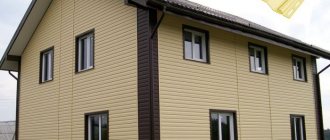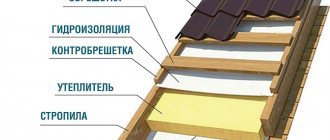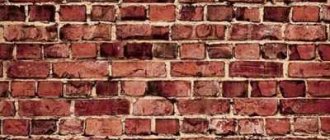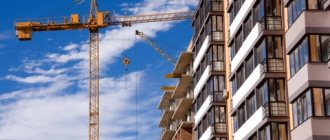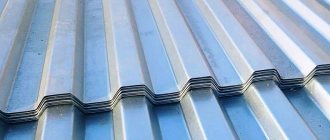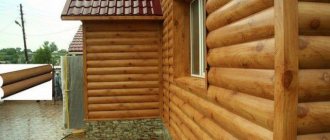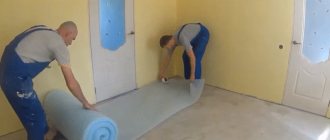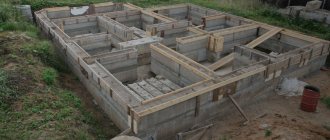Sheet roofing and its varieties
Metal tiles are durable, beautiful, but noisy
This roof covering is sometimes indistinguishable from expensive ceramic tiles. Metal tiles contain a cold-rolled steel sheet (from 0.4 mm to 0.5 mm thick) with a zinc coating, which is coated with one of the types of polymers for reliability. A protective varnish is applied on top, and there are several more layers inside. This is, in particular, a primer, as well as a passivating aluminum coating. The finished sheet is very light - from 3 to 5 kg per 1 m2.
Installation. During installation, the lower permissible roof slope is 150 (there is no upper limit). For small slopes, up to 200, it is necessary to hermetically seal the joints between the sheets. To fasten the roof to the sheathing, self-tapping screws with rubber gaskets are used. The overlap along the length of the sheets can be from 45 mm. up to 150 mm. depending on the type of metal tile profile.
An example of lathing for installation of metal tiles.
The scope of application of metal tiles is very wide. It is used as a roof for the roofs of private houses, industrial buildings, as a roof for garages, and kiosks. Often a flat roof is framed with metal tiles, laid at a slope. The result is a false roof.
The durability of this material suits the buyer quite well.
From 30 to 50 years nothing will happen to such a roof. Considering that you need to pay from $7 to $15 for one square meter of metal tiles, then this is a reasonable investment. Now specifically – about the good and the bad.
Algorithm for selecting the best coverage
Unfortunately, there is no universal algorithm that is ideal for everyone. What should you pay special attention to?
The material is selected taking into account the shape of the roof. If it is replete with elements and has a tendency towards eclecticism, then you can exclude sheet roofing types with a light heart, otherwise the wrong choice will result in literally a gigantic amount of waste - 30% is far from the limit. Therefore, in this case, it is better to advise considering other options - piece ones; with this choice, a large amount of material will not fly down the drain.
Pay attention to the cost of a particular roof. Yes, reasonable savings are a virtue, but by choosing the cheapest materials, you put an end to the durability of your roof. It should also be remembered that proper installation is the main condition for a long and happy life of the roof.
Soft roofing and its varieties
Flexible tiles - fiberglass plus bitumen
This covering is also called shingles, shiglas or simply soft roofing. To make it, a fiberglass base is impregnated with bitumen with a modifier, and stone chips (basalt or shale) are applied on top. This is what gives the roof UV protection, color and three-dimensional pattern. A self-adhesive layer of bitumen with polymer is applied on the inside.
Installation. The minimum roof slope for its installation is 110. Under this covering, a continuous sheathing made of waterproof plywood or OSB boards is required. At tilt angles up to 180, it is better to lay an additional layer of roll covering.
An example of a base for laying flexible tiles.
Application area. This roofing is good for use on roofs of complex shapes, as well as in the presence of an attic.
Durability and price. Its service life is up to 70 years. Inexpensive brands cost $5-10 per square meter.
+ Advantages of flexible roofing:
- Silence;
- ability to retain snow on rough surfaces;
- Beautiful design;
- absence of corrosion and condensation;
- flexibility.
- reasonable price.
— Disadvantages of flexible roofing:
- fragility in frost;
- melting and smell in the heat;
- flammability.
Roll fused roofing
It is also called hydroisol or stekloizol. However, some manufacturers give this material their own names, but the content does not change radically. This coating is made on the basis of fiberglass, fiberglass or polyester. Polyester is durable, but expensive, fiberglass is also not bad, but fiberglass does not shine with quality. The base is filled with oxidized bitumen, to which one of the types of modifiers has been added for elasticity and durability. This is either SBS (styrene-butadiene-styrene) or APPP (atactic polypropylene). Then there is a layer of polymer and a topping of sand, fine slate or mica.
Installation. The roof slope at which this material can be used must be at least 110. Insulation is placed on a solid base (made of wood, metal, concrete or flat slate), and waterproofing is placed on top. Next, apply primer or gasoline dissolved in bitumen. Using a gas torch, glue the roofing carpet, starting from the bottom. The end and side overlaps are made at least 10 cm.
Flat roof covered with rolled fused roofing.
Application area. This coating is used on flat roofs of multi-storey buildings - residential and industrial. In a private house, it can be used to construct waterproofing.
Durability and price. This roof lasts up to 50 years. The price per square meter is no more than $2.
+ Advantages of rolled fused roofing:
- The roof requires almost no maintenance;
- protection from fire, moisture and noise;
- environmental friendliness and harmlessness;
- low price;
- light weight.
— Disadvantages of rolled fused roofing:
- Rolls should only be stored in a standing position, away from heating appliances.
Flat membrane roofing
The membranes have a thickness of 0.8 to 2 mm. They can be of three types: PVC, EPDM and TPO. PVC membranes are not environmentally friendly, but they can protect against ultraviolet radiation and fire. EDPM membranes made of artificial rubber reinforced with a polyester mesh are durable and harmless to humans. TPO membranes consist of thermoplastic olefins with mesh reinforcement. They are also environmentally friendly.
Installation. The roof slope can be any, since the membranes are elastic. They are attached to the base (solid) in different ways, the best of which is considered to be hot air welding. On a roof with a large slope, the membrane is attached mechanically using special fasteners. If the slope is more than 100, you can use the ballast method by filling the roof with gravel. On complex roofs, membranes are glued.
Application area. This coating is used on fairly flat roofs of residential or public buildings.
Durability. The service life of the roof is up to 50 years. PVC membrane costs from $5 to $8 per square meter.
+ Pros of membrane roofing:
- The membranes have a large width, allowing you to cover any roof;
- no additional protection from moisture is required - the roof is already waterproof;
- the roof can be covered at any time of the year;
- installation takes place in a short time, repairs are rarely needed;
- puncture resistance is very high.
— Disadvantages of membrane roofing:
- It is necessary to carefully prepare the base, removing all pebbles;
- Solvents and organic oils can damage the roof.
Piece roofing materials
Ceramic tiles - very beautiful, but heavy and expensive
This roofing material is one of the oldest types of roofing materials, along with wood shingles and slate. To make tiles, clay is fired at a temperature of one thousand degrees, after which it becomes hard and durable, and the color becomes brown with a reddish tint. Some types of tiles are glazed before firing to increase water-repellent properties. Finished tiles (weighing 2 kg or more) have a length and width of 30 cm.
There are several types of clay tiles.
Here are the main ones:
- Strip flat tiles;
- strip groove tiles;
- stamped groove tiles;
- ceramic row tiles;
- single-wave tiles;
- two-wave tiles;
- grooved tiles.
Installation. It is preferable to construct a tiled roof with a roof slope of at least 25 and no more than 600. If it is less than 220, then it is imperative to provide a waterproofing layer and good ventilation. And a slope exceeding 600 will require more screws or nails for fastening. The individual elements (they are placed with the upper tiles overlapping the lower ones) are connected with special locks. The finished roof has the appearance of a continuous scale, so it has less chance of leaking. The tiles are attached to the sheathing with nails through special holes.
Application area. Use this roofing to cover roofs in houses made of brick, wood, and stone. The number of floors does not matter.
Durability and price. The durability of such a roof is impressive - it can last 150 years without repair. However, not everyone can afford such luxurious coverage. After all, its price per square meter ranges from $20 to $50.
+ Advantages of ceramic tiles:
- Economical operation - prevention and cleaning of gutters with valleys is needed only once a year;
- good sound insulation - rain will not interfere with sleeping under a tiled roof;
- non-flammability;
- corrosion resistance;
- frost resistance (at least 1000 freezing cycles);
- aesthetics, variety of tones and profiles;
- A tile roof is porous; it can “breathe” by evaporating water.
— Disadvantages of ceramic tiles:
- The weight of the roof is considerable - thicker or more frequent rafters are needed;
- the tiles are fragile;
- It is problematic to cover a complex roof with it - additional fasteners, sheathing, and insulation will be required;
- high price.
Material prices:
Sand-cement tiles are lighter than clay tiles, but do not last as long
This piece covering is made from a solution of sand and cement, which is not fired, but pressed under pressure. The dye is iron oxides, which make these tiles look like ceramic. Either glaze is applied on top or there is no coating. The surface is made smooth or with a convex profile pattern. This roof weighs from 35 to 40 kg (one square meter).
Installation. The optimal slope for installation is from 20 to 600. Fastening to the sheathing occurs in rows, through the holes on the tiles. In this case, a “bandage” is made equal to one-half the width of the tile. This is called the shift of a row relative to the neighboring one. The rafters are taken with a section of 5 by 15 cm, and the distance between them is from 60 to 90 cm. In addition to the sheathing, a layer of waterproofing is required.
Application area. This roof, like the previous one, can be used in houses made of various materials and with any number of floors.
Durability and price. Of course, it won’t last a hundred years, but the manufacturer gives a thirty-year guarantee. But the price of cement-sand tiles (from $10 to $20 per square meter) is lower than that of clay ones. And outwardly they are almost the same.
+ Advantages of sand-cement tiles:
- resistance to chemical aggression;
- resistance to sunlight;
- frost resistance (1000 freezing cycles).
— Disadvantages of sand-cement tiles:
- Greater thickness compared to ceramic tiles - at least a centimeter.
- up to a tenth of the material can be lost by breaking during careless transportation;
- the price is still high.
Material prices:
Slate roofing is a rare luxury coating
Nature itself produces this beautiful material using pressure and heat. Slate roofs can be seen on some ancient castles in Europe. However, if you wish, you can also buy slate tiles from us with a thickness of 4 mm and a weight of up to 25 kg (per square meter). It is made by hand, 15 or 30 cm wide and 20 or 60 cm long.
The roof is covered with slate roofing.
Installation. Slate can be laid on roofs with a slope of 250. The sheathing is made from rafters, the cross-section of which is 4 by 6 cm. We determine its pitch by dividing the length of the tile in half and slightly reducing the resulting number. Nails (copper or galvanized) for fastening are taken 9 or 10 cm long. For each tile, take two nails, on the edge and with a slope of more than 400 - three nails.
The principle of installation of slate roofing.
Durability and price. The service life of a slate roof is from 100 to 150 and even 200 years (provided the base is properly constructed). One square meter of material costs $65-100.
+ Advantages of slate roofing:
- Huge service life;
- exclusivity, wonderful appearance;
- color fastness, UV protection;
- water resistance, frost resistance, fire safety.
— Disadvantages of slate roofing:
- The price is too high.
Ondulin roof
To produce ondulin sheets, cellulose fiber, purified bitumen, and mineral filler are used and they are impregnated with polymer resin. This material for the roofing of a private house has high technical characteristics, which allows it to compete with other materials of this type.
Ondulin sheet dimensions
The main advantages of ondulin roofing:
- Environmental friendliness;
- High noise insulation properties of the house;
- This option is resistant to UV rays;
- Resistance to fungi, mold, insect damage;
- Light weight.
Fastening ondulin to special nails
The disadvantages of ondulin are:
- Weak resistance to temperature fluctuations;
- Low level of fire safety;
- Relatively short service life (up to 25 years).
Photo of the roof of a house made of ondulin
The cost of variants of this roofing material ranges from 300 to 600 rubles per sheet measuring 1.95 * 0.96 m.
